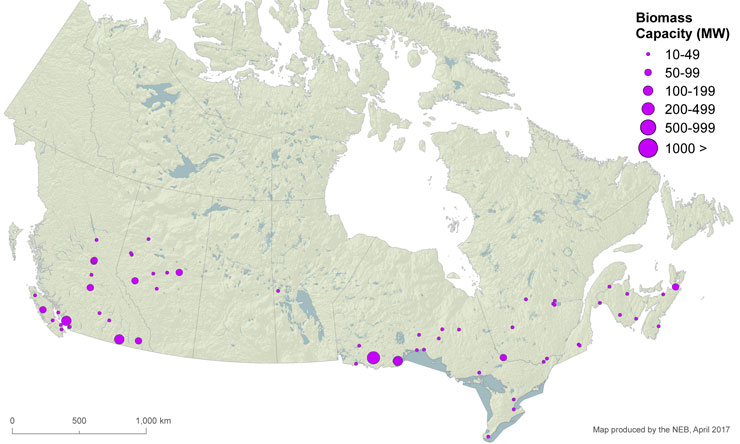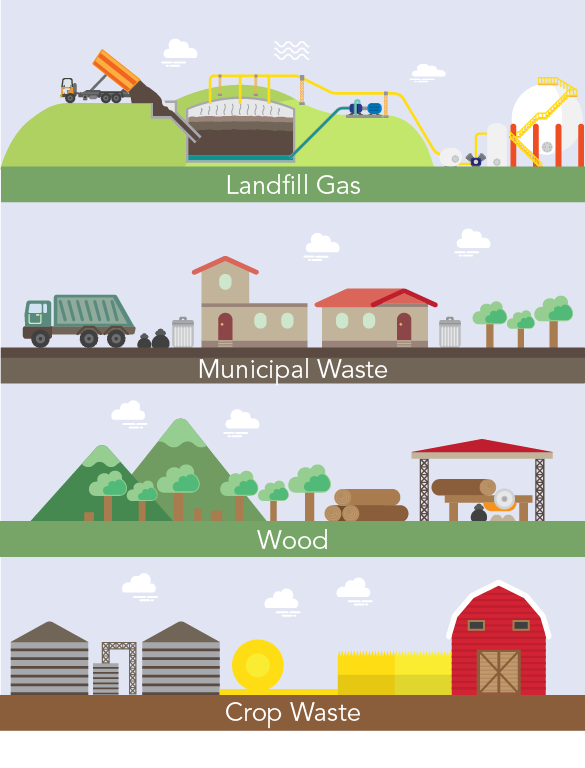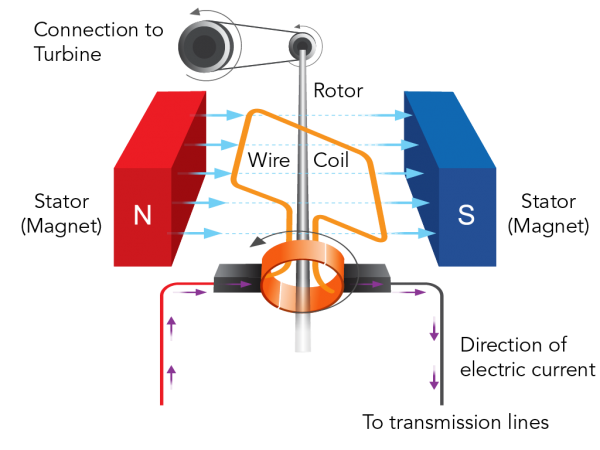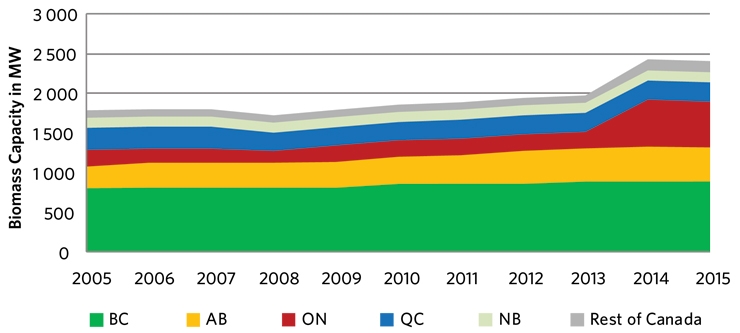Generating Electricity: Biomass
Some examples of biomass (mervin07, iStockphoto)
Some examples of biomass (mervin07, iStockphoto)
How does this align with my curriculum?
Learn how biomass can be used to generate electricity.
Biomass in Canada
1.4 percent of Canada’s electricity comes from biomass. Biomass is the third largest renewable source of electricity in Canada. The electricity generated from biomass increased 54% from 2005 to 2015. Most biomass plants are in British Columbia, Ontario, Quebec, Alberta, and New Brunswick.
Image - Text Version
Shown is a colour map of Canada with locations marked by purple dots of different sizes. The map is pale green with textures of mountains and other topographical features. Water is illustrated in greyish blue, and provincial borders are marked by thin grey lines. In the top right corner is a legend titled “Biomass Capacity (MW).” It shows that the smallest purple dots represent 10-19 MW, and get progressively larger to represent 50-99, 100-199, 200-499, and 500-999. The largest indicates greater than 1000 MW. The map shows the largest dot is in Western Ontario. There are slightly smaller ones in southern British Columbia and Ontario. Even smaller ones appear in central Alberta and across the rest of British Columbia. The smallest dots are scattered throughout southern Ontario, eastern Québec, New Brunswick and Nova Scotia.
Did you know?
Canada is the world’s second-largest exporter of wood pellets. Wood pellets are a type of biomass. Wood pellets are made of sawdust and other industrial waste.
What is biomass?
Biomass is organic material that comes from recently dead plants and animal waste. It contains energy that once came from the Sun. Plants convert energy from the Sun into chemical energy. This process is called photosynthesis. Animals eat plants to use and store this energy in their bodies.
Misconception Alert
Fossil fuels are not considered biomass.
Wood, waste from crops, landfill gas, and municipal solid waste are some of the common types of biomass. In Canada, industrial wood waste is the most common type of biomass.
Image - Text Version
Shown is a colour illustration of four different locations where biomass is sourced. The illustration is divided horizontally into four sections. The top section is labelled “Landfill Gas.” It shows a truck dumping brown material into an underground chamber. Wavy lines indicate gas rising from the surface of the material, near the roof of the chamber. Here, short pipes lead to a longer pipe connected to a round white tank. The second section is labelled “Municipal Waste.” This shows a truck on a street with two houses. It is pulled up next to two black garbage bags and a metal garbage can on the curb. The third section is labelled “Wood.” This shows three long logs piled next to a group of trees, with mountains in the background. To the right, a large log is on a table saw under a shelter. The bottom section is labelled “Crop Waste.” On the left, there are two silver grain silos on either side of a smaller silo with a pipe leading into it. In the middle are several bales of hay. On the right is a bright red barn.
How do we use biomass to generate electricity?
There are three ways of using biomass to generate electricity. Biomass is either:
Burning biomass is the most used method. This is also called combustion. The term for burning matter to generate electricity is thermal generation.
Electricity isn’t produced directly from this combustion. Burning solid biomass materials heats giant boilers filled with water. This transforms liquid water into steam. The steam creates pressure in the boiler. The force of the steam rotates a turbine. The turbine then moves a wire coil in a generator.
Some biomass plants generate electricity by burning methane. Methane is a gas that can be collected from landfills. These plants use a slightly different process than plants that burn solid biomass. The products of burning methane, instead of steam, cause the turbine to spin. As with solid biomass, the rotation of the turbine drives a generator.
Generators convert mechanical energy into electrical energy. First a force from the water vapour or gas makes the rotor turn. The rotor has a coil of wire that spins inside a fixed magnet around it, called the stator. The rotation causes changes in the magnetic field which forces electrons to move along the wire. This generates electric current. We call this electromagnetic induction. The metal wire constantly moves inside the magnet. This creates a continuous flow of electrons, generating electricity.
Did you know?
The type of current generated in this way we call alternating current.
Image - Text Version
Shown is a colour diagram illustrating how a generator works. At the top of the illustration are a large circle and a small circle, connected by a black line. The larger circle is labelled “Connection to Turbine.” Arrows indicate that both circles are rotating counter-clockwise. The smaller circle is mounted on the end of a long grey rod that runs down the centre of the illustration. This is labelled “Rotor.” Around the rotor is a thin orange line in the shape of a square with a stem at the bottom. This is labelled “Wire Coil.” The stem is attached to a matching orange ring. An arrow indicates this is also moving counter-clockwise. On the left side of the wire coil is a rectangular red cube with a white letter N on the front. This is labelled “Stator (Magnet).” Five pale blue arrows point from to the right, towards the wire coil. On the right side of the wire coil is a rectangular blue cube with a white letter S on the front. This is also labelled “Stator (Magnet).” Pale blue arrows point to the left side of this, connected by dotted lines that run from the right side of the other magnet. At the bottom of the illustration, a thin red line runs up and around to a small black block next to the left side of the orange ring. A thin black line runs from a matching block on the other side of the ring, over and down to the bottom of the illustration. Purple arrows point clockwise along both lines. This is labelled “Direction of electric current.” The bottom of the right-hand line is labelled “To transmission lines.”
Did you know?
Fuels made from biomass can run engines or heat homes.
How much power can biomass generate?
Biomass facilities can generate anywhere from 2 to 1000 megawatts of electricity. At the end of 2014, Canada had 70 biomass power plants. Together, these plants can produce 2 043 megawatts of electricity. Industries, such as pulp and paper plants, use about two-thirds of this electricity.
Atikokan Generating Station is North America’s largest 100% biomass power station. It is located in Northwestern Ontario. This station used to generate power by burning coal. After modifications in 2014, it now burns wood pellets. It can generate 205 megawatts of electricity by burning wood pellets. This is enough electricity to power about 70 000 homes.
Image - Text Version
Shown is a colour, stacked line graph showing biomass capacity for five provinces, from 2005 to 2014. The X axis is labelled “Biomass Capacity in MW.” This goes from 0 at the bottom to 3000 at the top. The Y axis is marked in one year increments from 2005 to 2015. Below, a legend shows that the green area of the graph represents British Columbia. Yellow represents Alberta, red Ontario, blue Québec and pale green New Brunswick. Grey is labelled “Rest of Canada.” British Columbia has the lowest amounts on the graph, starting at about 800 MW in 2005, and rising very slightly by 2015. Alberta starts at just over 1000 MW, and also rises slightly by 2015. Ontario starts at about 1250 MW in 2005. It doesn’t rise much at all until there is a sharp increase between 2013 and 2014. By 2015, Ontario’s capacity was almost 2000 megawatts. Québec, New Brunswick, and the rest of Canada follow a similar pattern to Ontario, increasing dramatically between 2013 and 2014. Québec starts at 1500 MW and ends at about 2100. New Bruswick starts at about 1750 and ends at 2250. The rest of Canada starts at 1800 and ends at about 2400.
Advantages of Biomass Electricity Generation
Unlike other types of renewable energy resources, biomass plants can generate power all the time. They don’t rely on intermittent things such as wind or sun. This makes electricity from biomass reliable.
But biomass is different from other types of renewable energy sources. Unlike the wind and the sun, biomass is consumed when electricity is generated. To make biomass renewable, the consumed plant material needs to be replaced as quickly as it is used. This may be through growing new crops or planting trees. If this were to happen, then burning biomass would not increase greenhouse gas levels. But if it does not happen, then burning biomass will increase greenhouse gas levels.
Another advantage of using biomass is that it can prevent some types of waste from going to landfills.
Disadvantages of Biomass Electricity Generation
Burning biomass produces similar greenhouse gases to burning fossil fuels. These greenhouse gases contribute to rising global temperatures. Burning biomass also releases other pollutants into the air. These pollutants include particulate matter, nitrogen oxides, and sulphur dioxide. Air pollution can cause respiratory issues, heart disease, cancer, and other health issues.
Biomass-generated electricity can also impact the environment in other ways. For example, cutting down trees can lead to deforestation. Growing plants to use as biomass can impact soil quality and water usage. Growing these plants instead of other plants can reduce biodiversity.
We could solve some of these problems with technology. For example, more careful land use, air filters or cleaner sources of biomass could help. Other sources of biomass, like methane gas from food waste, may be more common in the future. These technologies may make producing electricity from biomass better for the environment.
Learn More
Learn more about how methane from landfills can be captured and used to generate electricity from the Environmental Protection Agency.
Biofuels: An Alternative Energy Source
Biofuels are another way that we can generate energy from biomass. Learn more about biofuels in this article from Let’s Talk Science.
Electromagnetic Induction
This video, by Alom Shaha shows a simple demonstration of electromagnetic induction, the process at the heart of electric power stations. (3:00 min.)
References
Canada Energy Regulator. (2020 September 29). Canada’s Adoption of Renewable Power Sources- Energy Market Analysis, Biomass.
Cruichkshank, W.H., Robert, J.E., Silversides, C.R. (2014 September 9). Biomass Energy. The Canadian Encyclopedia
Clean Energy BC. (n.d.). Biomass Fact Sheet.
Natural Resources Canada. (2017 December 13). About Renewable Energy.
Turgeon, A., Morse, E. (2012 November 19). Biomass energy. National Geographic



